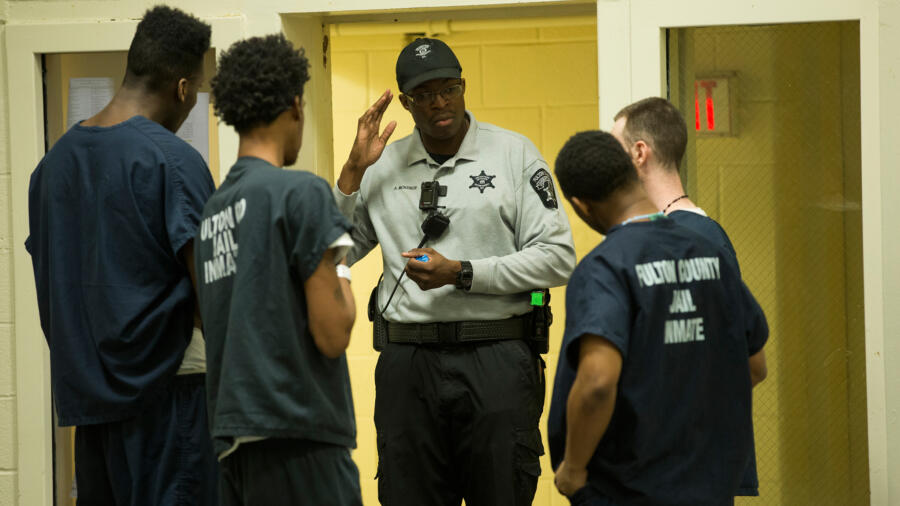For six seasons and counting, A&E’s 60 Days In has given TV viewers a unique look into jails across the country, by training the cameras on undercover inmates for two-month stretches.
The docuseries not only helps educate viewers about life on the inside, but also helps educate jail wardens and corrections officers about the work they are doing. A&E True Crime looks at how 60 Days In has helped spur change at some of these facilities.*
Clark County Jail in Jeffersonville, Indiana (Seasons 1 & 2)
In Jeffersonville, Indiana, many of the changes revolve around drug addiction and the flow of contraband.
Because of the undercover work conducted on the show, corrections officers at Clark County jail made a series of incremental changes to better root out contraband. For example, they started examining food trays more closely.
They were also able to ascertain more ways in which inmates were using materials available inside the jail for drug abuse. Officials removed sugar cubes from the commissary after the show revealed that inmates were using the sugar to brew hooch (i.e. jailhouse liquor). They also eliminated smokeless dissolvable tobacco products, which contain high levels of nicotine, once it became clear that inmates were crushing them up and snorting them.
Season 1 shed light on the prevalence of “cheeking,” wherein inmates would take their prescription pills into their mouths, but not swallow them—later removing them and selling those pills to fellow inmates. Since that season, corrections officers have more rigorously checked for “cheeked” pills.
The jail also invested resources in ramping up their drug detection efforts: They added a K-9 drug-detection dog, a full-body scanner, and a video-monitoring system courtesy of A&E to catch drugs as they entered the jail.
The facility says it also began working more productively toward reducing drug addiction and recidivism for those leaving the jail. Sheriff Jamey Noel credits many of those changes to a volunteer undercover inmate who became a full-time corrections officer at the jail after appearing on Season 2. The new efforts include a resource pamphlet for departing inmates with suggestions on how to peacefully reintegrate into free society and contact information for a plethora of services crucial to their success, including housing and food assistance, local mental-health providers, suicide hotlines and veteran’s support.
Noel says the results have been dramatic.
“It’s worked well,” he says. “We’re one of the few jails—if not the only—in the state of Indiana where our inmate population is actually consistently 20 to 30 percent lower on a daily average than everyone else’s inmate population. Everyone else’s numbers are going up.”
Fulton County Jail in Atlanta, Georgia (Seasons 3 & 4)
Like other participating jails in “60 Days In,” Chief Jailer Mark Adger of Atlanta’s Fulton County Jail saw on the show that drugs were being smuggled into the jail system, so he implemented several changes to combat that. He’s introduced a sorely needed upgraded video-surveillance system (and security video analytics) to the jail—the first such upgrade in more than 20 years.
After discovering that new inmates were regularly smuggling contraband into the facility in their body cavities, the jail implemented a new policy wherein all incoming inmates are strip searched in a padded cell right at intake.
[Stream Fulton County Jail episodes of 60 Days In in the A&E app.]
But there have also been changes to the culture and safety of the jail system at large. For example, since the show aired, Fulton County Jail has attempted to institute to a “New Generation” approach at the jail, one they say emphasizes positivity, consistency and fairness. The aim of the new tactic is to create a management style that moves away from the assumption that inmates are uncivilized.
Another flaw in the facility was exposed during a problematic mass evacuation drill, where inmates were cut and bruised from overly tightened flexicuffs. In response, the jail ordered old-fashioned steel handcuffs to replace the flexicuffs, which are safer to use.
Pinal County Jail in Florence, Arizona (Season 5)
For Pinal County, one of the most noteworthy changes since their jail was featured on the show has been the effort to ease detention officers’ workload. Whereas shifts previously ran 12 hours, they’ve been reduced to 8, to help improve both the mental health and the productivity of the officers.
As with other participating jails, officials responded to exposed holes in security with changes in their inspection protocols: on meal trays, with a body scanner and with a less predictable cell-check system. The facility also purchased industry-standard searching tools—such as extended mirrors, rolling carts and magnets—to allow detention officers to search for contraband with greater ease.
Etowah County Detention Center in Gadsden, Alabama (Season 6)
With Etowah County Jail’s season still underway, changes in this Alabaman corrections facility are still in their initial phases. But already Sheriff Jonathon Horton has seen changes, noting that, “The windows are fixed; the doors are fixed; the locks are fixed. [We have a] new x-ray machine—$150,000… We saw a tremendous amount of change in 10 months, and 90 percent of it has [been a result of] what we learned on this program.”
*Updates made to the jail facilities were implemented at the conclusion of production, but may have changed since.
Related Features:
Watch Full Episodes of ’60 Days In,’ No Sign In Required
Sheriff Jonathon Horton: From the Military to the Mortuary to ’60 Days In’
Sheriff Mark Lamb of ’60 Days In’ on the Pinal County Jail’s Biggest Challenges
What It’s Like to Work an iPhone After Being in Prison for 25 Years


